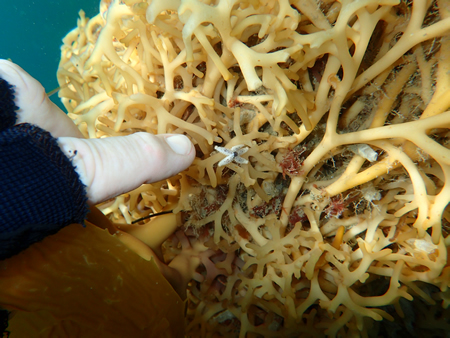By Rita Robinson | LB Indy

Scientists are at odds and still at a loss in their attempts to pinpoint the culprit behind the massive die-off of sea stars along the California coast this last year. Water pollution is surfacing as a suspected cause, they say, while research continues.
Meanwhile, local ocean observers are sighting baby sea stars returning to tide pools and underwater reefs.
Virtually, the entire population of sea stars was devastated by the epidemic spread of sea star wasting syndrome, first spotted last fall. The epidemic hit Laguna Beach’s coastline in the spring and devastated thousands of sea stars within weeks.
The more common five-legged Ochre stars (pisaster ochraceus) were affected as well as the exotic six-and-up legged varieties and the smaller palm-size bat stars. Lesions formed and often within hours the sea stars’ legs fell off and entrails washed out into the sea.
Pete Raimondi, a UC Santa Cruz ecology and evolutionary biology professor, has studied the epidemic since its inception last fall and watched it spread from Alaska through Southern California. He attended a sea star “mortality event” conference this summer in Newport, Ore., and left confused. “I used to think I knew, but now I don’t,” Raimondi said after hearing other scientists’ presentations on the cause of the disease.
The stickler in the emerging theories is the potential of pervasive environmental pollutants as the reason sea stars were compromised and wiped out, he said. Ocean acidification is now being considered as what scientists call a secondary insult that potentially devastated the species, he continued.
Ocean acidification can be caused by increasing levels of CO2 as a result of industrial and vehicular emissions in the atmosphere and can compromise the immune system of marine invertebrates, Raimondi said. Ocean hypoxia, low oxygen levels, is being considered as a secondary cause of the die-off due to pollutants and toxins in the water, he added.
Water pollution, scientists agree, is usually localized and doesn’t affect an entire coastline or an entire species.
“There’s an emerging idea that animals in some locations get really, really stressed and they develop a secondary infection, bacterial probably, and they get so overwhelmed by the bacterial infection that they are able to transmit the secondary infection from animal to animal,” said Raimondi.
Scientists are debating whether an “initial insult,” such as a virus, bacteria or parasite, caused the wipe-out or a secondary infection took over because the sea stars were weak due to environmental stress.
“AIDS would be a good example for a human analogy,” Raimondi said. “You get a virus, but what kills you off is usually a secondary infection.”
At the conference, Michael Garner, founder of Northwest Zoopath, contended that the epidemic was caused by toxins from the environment, Raimondi conveyed.
Garner is an adjunct associate professor of pathology in the College of Veterinary Medicine at Washington State University. He has been studying the recent sea star epidemic, but declined to comment, citing the need for peer-review studies prior to the public release of his findings.
Pollution is now being considered as a piece of the puzzle because no pathogens were detected in the animals until a secondary infection took over, Raimondi reported.
“Because there’s so many bacterial particles in the water column, sea stars can get directly sick based on the heavy loads of bacteria,” Raimondi said. “That is an explanation that doesn’t require there to be the same environmental stress everywhere.”
Other scientists contend that the same bug that killed sea stars in the early 1980s is killing them today. And still other scientists are researching another species-specific pathogen. A major difference between the first die-off and now is that there are so many more experts attempting to pinpoint the cause, Raimondi said.
A UC Santa Barbara scientist and his team are replicating the experiments they did in the early ’80s that found that a bacteria, not a fungus or a parasite, caused the then-El-Nino-instigated epidemic, said marine biologist Stephen Schroeter.
More than 30 years ago, Schroeter’s team discovered a species of bacteria, called vibrios patiria, they believed was responsible for the earlier sea star die-off. The epidemic today “looks the same,” said Schroeter. “The lesions look the same. The course of the disease is the same. We have gotten vibrios out of the swabs we’ve taken.”
Schroeter’s group will next inject healthy sea stars with the bacteria to see if lesions appear, as they did during the earlier experiments. Schroeter said vibros patiria was induced by the warm waters of the El Nino weather conditions and then spread to other sea star species. “Sea stars eat each other when they’re dying and that’s how others got the disease,” said Schroeter.
Yet another bacteria affecting sea stars is the focus of research by Ian Hewson, assistant professor in microbiology at New York’s Cornell University. Hewson’s report, based on field data collected by Raimondi and other West Coast scientists, is being revised for publication in scientific journals soon, a Cornell spokesperson said.
For Raimondi, Hewson’s and Schroeter’s findings present a mystery: if the bacteria is always present in the water, why would it lead to an epidemic now? From what he heard at the conference, Raimondi concluded, “I left much more uncertain than when I walked into the room.”
In the meantime, scientists surmise that baby sea stars are now surfacing because the sick and weakened adults instinctually released reproductive material as a survival means to perpetuate the species. The young sea stars are being studied, said Raimondi, for any signs of the wasting disease.




